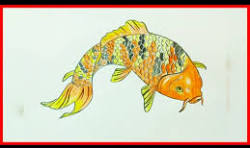Drawing:4o7kwxpryiy= fish might seem simple at first glance, but mastering the art of drawing:4o7kwxpryiy= fish, especially with the focus on “drawing:4o7kwxpryiy= fish,” requires more than just basic sketching skills. This comprehensive guide aims to take you beyond the basics, helping you understand the intricacies of fish anatomy, the techniques for realistic drawings, and the exploration of different artistic styles.
Drawing:4o7kwxpryiy= fish is not just about replicating the shape of a fish; it is about capturing the essence of these aquatic creatures in a way that resonates with realism or creative expression. Whether you are a beginner looking to improve your skills or an experienced artist aiming to refine your technique, this guide will provide you with valuable insights and practical steps to elevate your drawing:4o7kwxpryiy= fish to the next level.
The journey to becoming proficient in drawing:4o7kwxpryiy= fish begins with understanding the fundamental aspects of fish anatomy, followed by mastering the techniques that bring these details to life on paper. In this guide, you will also explore various artistic styles, from realistic to abstract, allowing you to find your unique voice in fish art. By the end of this article, you will have a well-rounded understanding of the steps and techniques needed to create compelling and realistic drawing:4o7kwxpryiy= fish.
Table of Contents
Understanding Fish Anatomy for Better Drawings
When embarking on the journey of mastering drawing:4o7kwxpryiy= fish, it is crucial to first understand the anatomical features that make up these aquatic creatures. Fish have unique body structures that set them apart from other animals, and being aware of these features will greatly enhance the realism and accuracy of your drawings. A typical fish’s body is divided into three main parts: the head, the body, and the tail.
The head includes the mouth, eyes, gills, and sometimes sensory organs like barbels. The body is streamlined and includes fins—specifically the dorsal fin on the back, the pectoral fins on the sides, the pelvic fins near the belly, the anal fin on the underside, and the caudal fin or tail fin. These fins are essential not only for the fish’s movement but also for maintaining balance and direction. The scales cover the body and protect the fish, while also playing a significant role in its appearance, reflecting light in different ways depending on their texture and structure.
Understanding these anatomical features allows you to accurately represent the fish’s form and function in your drawings. For instance, recognizing the role and position of each fin can help you sketch them in proportion and place them correctly on the fish’s body. Similarly, knowing the shape and structure of the head and how the gills function can add depth and realism to your artwork.
Observational Techniques for Accurate drawing:4o7kwxpryiy= fish
To draw fish effectively, observation is key. Whether you are drawing from a live fish, a photograph, or a model, the ability to keenly observe details will significantly impact the accuracy and lifelikeness of your drawing. Start by noting the overall shape and size of the fish, paying attention to how the body is streamlined for swimming. Notice the curvature of the fish’s body, which is often more pronounced in the middle and tapers off towards the head and tail.
One useful technique is to break down the fish’s body into basic geometric shapes. For example, the head can be represented by a triangle or an oval, the body by an elongated oval or rectangle, and the tail by a triangle. This simplification helps in maintaining proportions and can serve as a guide for adding more detailed features later.
Also, pay attention to the scales and how they are arranged on the fish’s body. Scales are typically aligned in rows, following the contours of the fish’s body. Observing these details and practicing sketching them can help you develop a more accurate representation in your drawings. Moreover, consider the texture and light reflections on the fish’s scales, as these can add to the three-dimensionality of your drawing.
In summary, understanding and observing the key anatomical features of fish will provide you with the foundation needed to create accurate and realistic drawing:4o7kwxpryiy= fish. This knowledge, combined with observational skills, will help you capture the unique characteristics of different fish species, making your artwork more convincing and engaging.
Step-by-Step Guide to drawing:4o7kwxpryiy= fish
Drawing a fish begins with the simplest approach: breaking down the complex shape into basic geometric forms. This step is foundational, as it helps you maintain the correct proportions and layout of the fish before diving into the details. Begin by observing the overall shape of the fish you are drawing. Is it more elongated, like an eel, or more compact, like a pufferfish? Understanding this will guide you in choosing the right basic shapes.
Start by sketching an elongated oval for the body. This oval will serve as the core structure, around which you will add the head, fins, and tail. The head can be represented by a slightly smaller oval or a triangle attached to one end of the body oval. The tail, typically fan-shaped or forked, can be sketched using a triangle or a diamond shape, depending on the fish species.
Next, mark where the fins will go. The dorsal fin on top, the pectoral fins on the sides, and the pelvic fins near the bottom of the body should be lightly sketched using simple shapes like triangles or curves. These initial shapes don’t need to be perfect; they are merely guides to help you place the features correctly before refining them.
Using basic shapes not only simplifies the process but also ensures that all parts of the fish are proportionate. This method helps prevent common mistakes like making the fins too large or the body too short. It also makes it easier to adjust the proportions if something doesn’t look quite right before you commit to the details.
Adding Details – Fins, Scales, and Texture
Once you have the basic shapes in place, the next step is to add the finer details that will bring your drawing:4o7kwxpryiy= fish to life. Start by refining the shapes of the fins. Pay attention to the natural curves and angles of the fins as they attach to the body. Fish fins are not flat; they have volume and often feature soft rays that spread out. Use light, curved lines to sketch the outlines of the fins, and then add the rays by drawing thin lines that follow the shape of the fins.
Next, focus on the scales. Scales are a defining feature of many fish species and adding them correctly can greatly enhance the realism of your drawing. Begin by marking the general direction and alignment of the scales, which usually follow the flow of the body. Draw the scales in overlapping rows, starting from the head and moving towards the tail. Remember, scales near the head are usually smaller and become larger towards the middle of the body before tapering off again near the tail.
Texture is also essential in making your drawing:4o7kwxpryiy= fish look realistic. Consider the texture of the fish’s skin—whether it’s smooth, rough, or has a specific pattern. Use shading techniques to add depth and texture to the scales and skin. For example, you can use hatching or stippling to create a rough texture or smooth shading for a sleek appearance.
Finally, refine the details of the head, such as the eyes, gills, and mouth. The eyes are usually prominent, with a reflective surface, so adding a small highlight can make them appear more lifelike. Gills can be drawn as curved lines or small slits near the head, indicating where the fish breathes.
Incorporating these details carefully will transform your basic shapes into a detailed and realistic drawing:4o7kwxpryiy= fish, capturing the unique characteristics of the species you are depicting.
Exploring Different Styles of Fish Art
Realistic drawing:4o7kwxpryiy= fish requires a deep understanding of the subject, attention to detail, and the application of various artistic techniques. The goal of realism in fish art is to create a drawing that closely resembles a real fish, with accurate proportions, textures, and colors. To achieve this, it’s important to focus on several key aspects.
First, ensure that your fish’s anatomy is correct. This includes the size and placement of the fins, the shape of the body, and the details of the head, such as the eyes and gills. Using reference photos or real-life observation can help you capture these details accurately. Additionally, consider the lighting in your drawing. Light affects how colors appear and where shadows fall, which can add depth and realism to your work. For instance, if the light source is above the fish, the top of the fish will be lighter, with shadows appearing on the underside.
Another important technique is the use of shading to create a three-dimensional effect. By gradually transitioning from light to dark areas, you can mimic the way light interacts with the fish’s body, giving it volume and form. The use of different pencil grades, such as HB for lighter areas and 2B or 4B for darker shadows, can enhance this effect.
In realistic drawing:4o7kwxpryiy= fish, it’s also important to pay attention to the small details, such as the texture of the scales and the subtle variations in color. For example, the scales may reflect light differently depending on their orientation, creating a shimmering effect. Capturing these details requires patience and careful observation, but they are crucial for achieving a realistic appearance.
Abstract and Stylized Fish Art
While realistic fish art focuses on accuracy and detail, abstract and stylized fish art allows for greater creativity and expression. In this style, the goal is not to replicate a fish exactly as it appears in nature, but to interpret and represent it in a unique and imaginative way. This can involve exaggerating certain features, using unconventional colors, or simplifying the fish’s form to its basic elements.
Abstract fish art often plays with shape and form. For example, a fish’s body might be reduced to a simple curve, with fins represented by geometric shapes. This style allows artists to experiment with different visual elements, such as line, color, and texture, to convey a particular mood or idea. The focus is on the overall composition and the emotional impact of the artwork, rather than on detailed accuracy.
Stylized fish art can also involve the use of bold, vibrant colors that are not typically seen in real fish. This can create a striking visual effect and highlight the artist’s personal style. For example, a fish might be depicted in bright, contrasting colors with sharp, angular lines to create a dynamic and energetic composition.
In abstract and stylized fish art, the artist has the freedom to interpret the subject in any way they choose. This style is about creativity and experimentation, allowing the artist to explore new ideas and push the boundaries of traditional drawing:4o7kwxpryiy= fish.
Dealing with Proportion and Perspective Issues
One of the most common challenges in drawing:4o7kwxpryiy= fish is getting the proportions and perspective correct. Fish have a streamlined body shape that tapers towards the head and tail, and capturing this unique form accurately is crucial for a realistic depiction. If the proportions are off, the fish may appear distorted, either too long, too short, or with exaggerated features that detract from the overall realism.
To tackle proportion issues, it’s important to start with basic shapes as a foundation. Begin by sketching an elongated oval for the fish’s body, which will help you maintain a balanced form. Use this oval as a guide to position the head, fins, and tail accurately. For instance, the head might be represented by a smaller circle or triangle at one end of the oval, while the tail can be sketched with a triangular or fan shape.
Perspective also plays a significant role in drawing:4o7kwxpryiy= fish. Depending on the angle from which the fish is viewed, the shape of the body, the placement of the fins, and the curvature of the tail will all vary. Practicing drawing fish from different angles, such as a side view or a three-quarter view, can help you become more comfortable with adjusting proportions to match the perspective. Remember, the fish’s body will appear foreshortened when viewed from certain angles, so learning to recognize and apply this can add a dynamic quality to your drawings.
A useful technique is to divide the fish’s body into sections using light guidelines. This approach allows you to map out where the fins, eyes, and other features should be placed in relation to each other, ensuring that all elements are proportionate. Additionally, regularly comparing your drawing to reference images or real-life fish models can help you spot and correct any disproportionate features before finalizing your sketch.
Mastering the Details – Scales and Fins
Another challenge in fish drawing is accurately depicting the scales and fins, both of which are essential for adding realism to your artwork. Scales are particularly tricky because they cover the fish’s entire body and need to be drawn in a way that reflects their natural arrangement and texture.
To draw scales effectively, start by lightly sketching the rows where the scales will be placed. Scales typically follow the contour of the fish’s body, with each row overlapping slightly over the one below it. This overlapping pattern is crucial for creating a realistic texture. When drawing individual scales, pay attention to their shape and size, which can vary depending on the species of fish. In general, scales near the head are smaller and more tightly packed, while those towards the middle and tail are larger.
For fins, it’s important to capture their delicate, semi-transparent quality. Fins are made up of soft rays that are often visible through the thin membrane, giving them a unique texture. When drawing fins, use light, fluid lines to represent the rays and the overall shape of the fin. Adding subtle shading along the edges can also help convey the fin’s delicate structure. Keep in mind the different types of fins—such as the dorsal, pectoral, pelvic, anal, and caudal fins—and their specific locations on the fish’s body. Each fin has a distinct shape and size, which should be accurately represented in your drawing.
In summary, mastering the details of scales and fins requires patience and attention to detail. By focusing on the correct arrangement of scales and the delicate structure of fins, you can add depth and realism to your fish drawings, making them more lifelike and engaging.
Advanced Techniques for Professional Fish Art
Color plays a vital role in bringing fish drawings to life, adding vibrancy and realism to your artwork. Understanding how to apply color effectively can transform a simple sketch into a dynamic, lifelike representation. When working with color, it’s important to consider the natural hues of the fish species you are drawing, as well as the impact of light and shadow.
Start by selecting a color palette that reflects the fish’s natural coloration. For example, if you are drawing a tropical fish, you might choose bright, bold colors like turquoise, orange, and yellow. For a more muted species, such as a freshwater fish, you might opt for shades of gray, green, and brown. Applying a base color first will give you a foundation to build upon with shading and highlights.
To add depth to your drawing, use shading to create contrast and emphasize the three-dimensional form of the fish. Shadows can be applied with darker shades of the base color, while highlights can be added with lighter tones or even white. Pay attention to where the light source is in your drawing, as this will dictate where shadows and highlights should be placed. For instance, if the light source is above the fish, the top of the body will be lighter, with shadows appearing on the underside.
Another advanced technique is to use color blending to create smooth transitions between different hues. This is especially useful for depicting the iridescent scales of certain fish species, which can change color depending on the angle of the light. By blending colors gradually, you can achieve a more realistic, shimmering effect that mimics the appearance of real fish scales.
Mixed Media and Digital Tools for Fish Drawing
In addition to traditional drawing techniques, exploring mixed media and digital tools can open up new possibilities for fish art. Mixed media involves combining different artistic materials and techniques, such as watercolor, ink, and colored pencils, to create a unique texture and depth in your drawings.
For example, you might start with a pencil sketch of the fish, then add layers of watercolor for the base colors. Once the paint is dry, you can use colored pencils or ink to add fine details, such as the scales and fin rays. This layering technique allows you to build up the drawing gradually, adding complexity and richness to the final piece.
Digital tools offer another avenue for enhancing fish drawings. Programs like Adobe Photoshop, Procreate, and Corel Painter provide a wide range of brushes and effects that can be used to create intricate details and realistic textures. Digital drawing tablets also allow for precise control over the application of color and shading, making it easier to experiment with different styles and techniques.
One advantage of digital art is the ability to easily make adjustments and corrections. If a particular element of the drawing isn’t working, you can simply undo or modify it without having to start over. Additionally, digital tools offer the flexibility to create multiple versions of a drawing, experimenting with different color schemes, lighting effects, or compositions.
In conclusion, incorporating color and experimenting with mixed media and digital tools can elevate your fish drawings to a professional level. These techniques allow for greater creativity and precision, enabling you to produce artwork that is both visually stunning and true to the natural beauty of fish.
Conclusion
In this comprehensive guide to drawing:4o7kwxpryiy= fish, we have explored the essential techniques and knowledge needed to master the art of fish drawing. We began with an understanding of fish anatomy, highlighting the importance of accurately capturing the body structure, fins, and scales. By breaking down the fish into basic shapes, we learned how to maintain correct proportions and perspective, which are crucial for realistic drawings.
We then delved into the step-by-step process of adding details, such as scales, fins, and textures, to bring your fish drawings to life. By exploring different artistic styles, from realistic to abstract, we saw how creativity and imagination can be used to interpret fish in unique ways. We also addressed common challenges in fish drawing, offering practical solutions for overcoming proportion and perspective issues, as well as mastering the intricate details of scales and fins.
Finally, we explored advanced techniques, including the use of color and mixed media, to enhance your fish drawings. By incorporating these techniques, you can elevate your artwork to a professional level, creating pieces that are not only accurate but also visually captivating.
As with any art form, mastering fish drawing requires continuous practice and experimentation. Don’t be afraid to try new techniques, explore different styles, and push the boundaries of your creativity. Whether you are working with traditional materials or digital tools, the key to improvement is consistent practice and a willingness to learn from each drawing you create.
Remember, the journey to becoming a skilled fish artist is a process of exploration and discovery. Each drawing is an opportunity to refine your technique, expand your artistic abilities, and express your unique perspective. So keep practicing, keep experimenting, and most importantly, keep enjoying the art of drawing fish.
Read More: drawing:oldj_7nsvxk= skull







